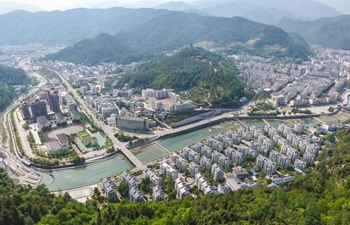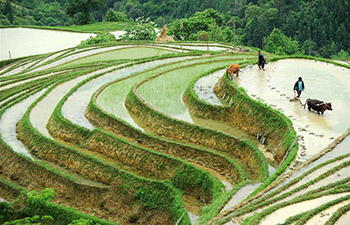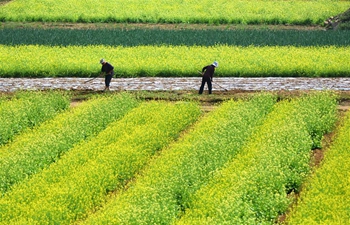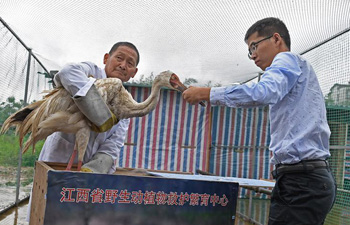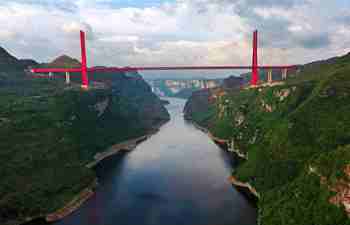By H. L. Bentley
CHENGDU, May 12 (Xinhua) -- In Beichuan, Sichuan Province, time stands still. This town was once home to 160,000 people, now the only signs of life are flurries of white butterflies that flutter among the wreckage of collapsed homes, crumbled buildings and crushed cars.
At twenty-eight minutes past two on the afternoon of May 12, 2008, Sichuan was struck by a mighty earthquake, 8.0 on the Richter scale, so sudden and powerful, that many residents had neither time to run nor hide. Tens of thousands of people were killed.
In Sichuan, they call the sharing of stories "Bai Long Men Zhen," or simply: dragons talking. Ten years on from the Wenchuan earthquake, I traveled across the Dragon Gate mountain fault zone to see how the province has risen again; to hear the dragon speak.
Across the plains
Chengdu is 70-km from the epicenter. The city lies on the Sichuan plains in the heart of the ancient Chinese empire, but the plains suffered drought and floods. Water from the mountains besieged the city.
It was a Qin-dynasty governor who began the mammoth Dujiangyan irrigation project, which was to change the course of the river. Before the invention of dynamite, the mountain face was heated with fires and the frigid river water was used to crack and weaken the rock. The work took six years.
Only 25-km from the epicenter, Dujiangyan was all but destroyed, but, despite early concerns about cracks, the irrigation works stands intact.
The day the sky fell
A 88-km drive to the northeast of that ancient engineering marvel is Luobozhai, at 2,000-meters above sea level。 This tiny community is known locally as the "village in the clouds."
Tremors were not unknown in Luobozhai. Back in the 1970s, local officials would warn villagers to find safe ground by shouting through loudhailers, but nothing they had ever experienced could prepare the village for the terror to come.
A whole village was destroyed. No family spared. Lives extinguished under rubble and mud. Loved ones vanished, never to be seen again.
"It felt like the end of the world. I never thought I would live to see today," Wang Baojian, who ran a small family home stay, told me.
He had stepped outside when the earthquake struck, meaning he was safe. His sister no so. She had rushed back inside her house to save her baby, moments before it collapsed. Their bodies were last to be pulled from the wreckage of the village.
"Throughout the search and rescue I knew where they were -- we just couldn't get them out."
Luobozhai, with clean mountain air and unbelievable views, has always been a popular tourist destination. After the earthquake, one of Wang's former guests wrote to ask if he had survived, and when he could come to visit. It was six months before Mr Wang could contact the concerned guest. In an emotional phone call, he said; "there is nothing left to visit." The reply was a simple kindness "Things can always be bought again. What do you need?"
The guest, along with others who had enjoyed Wang's hospitality, sent him 260,000 yuan (about 41,000 U.S. dollars), which along with 90,000 yuan from the government, meant Wang was able to rebuild his home stay and his life. Meanwhile the original village has been abandoned, the crumbling buildings left to stand in silent testament to all those who perished.
Lessons learned
After the earthquake, a huge financial package helped rebuilding. Laws were changed, building standards were raised. This tragedy, it was promised, would never be repeated.
Sichuan was faced with a huge task -- to build itself back up -- and provinces, municipalities and autonomous regions across China helped with reconstruction where they could. Wenchuan No. 1 Primary School, for example, was rebuilt with help from Guangdong. The campus is bright and airy. Walls are decorated with students' paper cutting, embroidery and art. While the corridors of the higher stories of the building are full of the laughter and chatter of excitable children, the ground floor is eerily quiet.
In the chaos of the earthquake, people, many people, were crushed to death as buildings collapsed. That's why this campus has no classrooms on the ground floor, and why students go through a practice drill at least once a year. They must stay in class for 2-3 minutes after the alarm sounds, awaiting the severity of the incident to be determined. Those are very long minutes.
Yingxiu is less than three-km away from the epicenter. In what was once a thriving town the ground appears to be swallowing the bowed walls and crumbled roof of a school. It is a poignant memorial to those who died. For the survivors, in the days that followed the earthquake, their problems were far from over. Infrastructure was in tatters, and they were cut off from basic amenities like water and electricity.
Liu Yong from Yingxiu State Grid was one of the first people on the scene. As his wife was airlifted to hospital, Liu stayed to help. It would take three months to fully reconnect Yingxiu. The area survived on an intermittent supply from generators. The experience was to prove a hugely important lesson, and one which would pay off in the future. After the 2017 earthquake in Jiuzhaigou, Sichuan, the State Grid was able to reconnect the area within 48 hours.
Today, those affected have returned to some kind of normality, often a forgotten part of the recovery process. When shattered lives are put back together -- stronger and more vital than ever before -- only then can the dragon begin to tell its tales.







